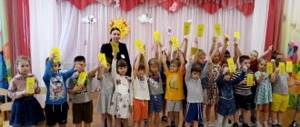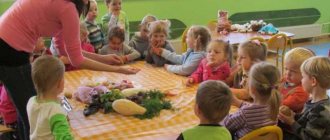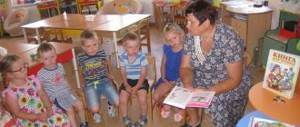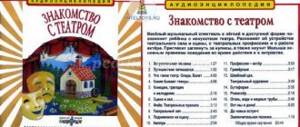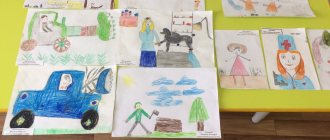Thematic planning "Theater Week" in the 2nd junior group material (junior group) on the topic
Cognition: Introduce children to theater through dramatization games based on works of children's literature.
Give an idea of the attributes of the theater (auditorium, tickets, stage, curtain).
Teach the rules of behavior in the theater: spectators are seated strictly in their seats; talking and making noise in the theater is prohibited during the performance.
Reading fiction:
To develop the ability to listen to fairy tales, follow the development of the action, and empathize with the heroes of the work.
Develop the ability, with the help of a teacher, to dramatize short excerpts from fairy tales.
Communication:
Develop a dialogical form of speech, involve children in conversation after watching the performance.
Socialization:
To promote the emergence of games based on literary works (rhymes, songs, fairy tales, poems).
Develop the desire to improvise, independently select attributes for a particular role.
Music:
To develop emotional responsiveness to works, the ability to distinguish between happy and sad music.
To develop skills in more accurately performing movements that convey the character of the animals depicted.
Preview:
Thematic planning “Theater Week” in the 2nd junior group
Cognition: Introduce children to theater through dramatization games based on works of children's literature.
Give an idea of the attributes of the theater (auditorium, tickets, stage, curtain).
Teach the rules of behavior in the theater: spectators are seated strictly in their seats; talking and making noise in the theater is prohibited during the performance.
Reading fiction:
To develop the ability to listen to fairy tales, follow the development of the action, and empathize with the heroes of the work.
Develop the ability, with the help of a teacher, to dramatize short excerpts from fairy tales.
Develop a dialogical form of speech, involve children in conversation after watching the performance.
To promote the emergence of games based on literary works (rhymes, songs, fairy tales, poems).
Develop the desire to improvise, independently select attributes for a particular role.
To develop emotional responsiveness to works, the ability to distinguish between happy and sad music.
To develop skills in more accurately performing movements that convey the character of the animals depicted.
Goal: To introduce children to the theater, to arouse interest in theatrical activities, to develop the emotional and sensory sphere of children, encouraging them to express their feelings, to communicate, to teach them to listen to a poetic text and correlate its meaning with expressive movement to music.
Conversation “Hurray! Let's go to the theater! » — expand knowledge about the rules of conduct in the theater, develop the ability to apply your knowledge in conversation
— Speech situation “Theater secrets” - expand knowledge about the rules of behavior in the theater, develop dialogic speech, independence of judgment
-Exercise to enrich vocabulary: “Bear-bears”, “Hare-hares”, “Wolf-wolves”... - enrich vocabulary, the ability to form nouns in the plural
- D/game “Collect a fairy tale” - consolidate knowledge about the content of the fairy tale “Teremok”, the sequence of events
— Mimic sketches: “The hare got scared”, “Hungry, angry wolf”, “Kind little fox” - to develop the ability to convey the emotional state and character of a character using facial expressions
Staging "Turnip" (with bibabo dolls).
Working with parents
Consultation “Home theater as a means of forming relationships in the family” - to interest parents in purchasing and making different types of theater and provide information on ways to play at home with their children
Game exercise “We are artists” (imitation of movements to music: clumsy bears, jumping bunnies, mice, foxes, horses...)
— Riddle game “Guess and tell me who I’m talking about” - develop imaginative thinking, recognize a character by characteristic features
-Exercises on intonation expressiveness: “I am a sly fox”, “I am a sad hare” - exercise the ability to intonationally convey the emotional state of the hero.
— D/game (TRIZ) “Teremok” - develop analytical thinking, the ability to identify common features through comparison, expand knowledge about wild animals
- Each player is dealt cards with images of various objects. One card for each participant. If you are playing together, you can simply put the deck of children’s cards face down and take turns pulling out the pictures. One of the players is appointed as the owner of a conditional little house (a rug or a children's house), and the others (or another) approach the little house and ask to join him in the house (using the example of a fairy tale):
- Knock, knock, who lives in the little house? - Me, Guitar. And who are you? - And I am a fishing rod. Let me into the mansion? “If you tell me how you are like me, then I’ll let you in.”
(The guest must compare both drawings, identify common features and name them. For example, both guitars and fishing rods are made of wood. Or both guitars and fishing rods have a string - a rope.)
— Let’s draw a teremok (drawing with a brush) - continue to learn how to draw straight lines with paints, holding the brush correctly
Toy Theater - fairy tale "The Fox and the Hare".
Purpose: to give children an idea of the toy theater on the carpet. Learn to listen carefully to a fairy tale and follow the plot.
Reading the Russian folk tale "Geese and Swans"
Working with parents
Mobile folder “How to raise a young theatergoer” - recommendations for parents on how to properly introduce their child to the theater
Finger games “Grey Bunny”, “Chicken-Tatatorochka”, etc.
Games with the finger theater "Teremok" - expand vocabulary, creative and artistic abilities
— Outdoor game “Animals” — to train in the ability to act on a signal from the teacher, to imitate the habits of animals
The game "Curtain" - to develop children's imaginative thinking, the ability to convey the character of a character using facial expressions and gestures
— Guessing riddles about animals — to develop logical, imaginative thinking
Reading the fairy tale “Kolobok”, dramatizing the fairy tale using a tabletop theater
Purpose: To recall the content of the fairy tale, to teach children to hum Kolobok’s song, to promote the development of imagination in children. Arouse joy and desire to help the main character of the fairy tale.
Music box “Little gray cat...”
Goal: To encourage children to enjoy folk music, to promote the development of skills in expressive and emotional transmission of playful and fairy-tale images.
Theater week in the group “Krokha” (2nd junior group)
MONDAY
Morning:
1. Consideration of illustrations for Russian folk tales.
Goal : To help children understand the content of the fairy tale based on the image. Arouse in children the need for emotional communication.
2. Mobile exercise “Find the bear.”
Goal : To teach children to walk in a given direction, observing a certain rhythm of movement, to evoke the joy of playing with a fairy-tale character.
There, at the end of the path, Look at the house. Who, my good one, lives in it? Could it be a cat? Maybe it's a mouse? Maybe the fidgety Mishka is a naughty girl?
3. Lesson on getting to know the environment “Who did we meet in the forest?” (based on the fairy tale “Mitten”).
Goal : To introduce children to the fairy tale. Reinforce the idea of wild animals by noting and naming their features
.
Walk:
Mobile exercise “Teddy Bear”
Goal : To teach children to accompany their actions with speech, to pronounce the content of their favorite nursery rhyme.
A clubfooted bear is walking through the forest. He collects the cones and puts them in his pocket.
Evening:
1. Puppet show in the music hall.
2..Consultation for parents “Fairy tale in the lives of children.”
Goal : To provide parents with an accessible explanation of the meaning of fairy tales in the development of children, its influence on the emotional state of children.
TUESDAY
Morning:
1. Didactic game “Cockerel and his family.”
Goal : Continue to familiarize children with folklore works. Tell children about poultry (appearance, habits, voice).
Petya, Petya, cockerel, lend your voice. Across the field, across the river Shout to us “KU – KA – RE – KU!” ”
2. Tabletop theater. An adaptation of the Russian folk tale “Ryaba Hen”.
Goal : Tell a fairy tale, accompanying the text with a display of tabletop theater figures. Make children want to listen to the story again.
Lesson on speech development. Reading the fairy tale “Kolobok”, dramatizing the fairy tale.
Purpose : To recall the content of the fairy tale, to teach children to hum Kolobok’s song, to promote the development of imagination in children. Arouse joy and desire to help the main character of the fairy tale.
Individual work on PHYS. Didactic game “Who is screaming? "
Goal : To consolidate children's knowledge about domestic and wild animals. Continue to teach children to imitate the voice and habits of animals.
Evening:
1. Outdoor game “Hen and Chicks”.
Goal : To develop attention, speed and dexterity in children.
2. Games with building materials “Build a house for the Cockerel and his family.”
Goal: Create a fabulous game situation. Make children want to take part in the adult’s venture. Foster a caring attitude towards pets. Give the opportunity to independently act with the construction.
WEDNESDAY
Morning:
1. Talk with children about their favorite cartoons.
Goal : To develop in children the ability to engage in dialogue and use simple phrases. Make kids happy when remembering their favorite cartoons.
2. Mobile exercise “Bear and children”.
Goal : Continue to teach children to run in a given direction, to act in accordance with the words of the fairy tale text. Encourage children to enjoy joint actions with a fairy-tale character.
The bear was walking through the forest. The bear was looking for the kids. He searched for a long, long time, sat down on the grass and dozed off. The children began to dance and began to tap their feet. Bear, Mishenka, get up, catch up with our children.
Drawing lesson “The chicken laid an egg.”
Goal : To teach children to draw round objects, to paint without going beyond the contours. Reinforce the content of the story.
Walk:
Mobile exercise “By a bear in the forest.”
Goal : Continue to teach children to run in different directions without bumping into each other. To develop children's imagination and ability to take on a certain role. Arouse interest in the game.
Evening:
1. Theatricalization of the Russian folk tale “Teremok”.
Goal : To teach children to understand the emotional state of the heroes of a fairy tale, to help children understand its content, to promote the development of imagination in children.
2. Didactic game “Cheerful - Sad”.
Goal : Continue to teach children to understand the emotional state, to transfer the character’s emotional state to themselves.
THURSDAY
Morning:
1. Telling the fairy tale “Zayushkina’s hut.”
Goal : Introduce children to a new fairy tale. Cultivate a kind attitude towards animals, compassion for the main character.
Time plan
Theatrical activities for pupils of the first and second junior groups last 15 and 20 minutes, respectively. In this case, the stages between which this time period is distributed will be the same:
- introduction - introduction to the topic, use of motivational techniques (up to 3 minutes),
- the main stage is elaboration of the topic in one of the types of theatrical activities (up to 14 minutes),
- the final stage is summing up, encouraging the kids (up to 3 minutes).
Each stage of theatrical activity has a clear time frame
Table: Evseeva E.V. lesson notes on theatrical activities “A steam locomotive took the kids” in the first junior group
| Stage | Content |
| Introduction | The teacher brings the children a toy steam locomotive and says that the locomotive will soon set off. Educator: - Steam locomotive, steam locomotive, he brought trailers, chuh-chuch chuh! Guys, look how beautiful the train is. Do you want to go for a ride? Go! (Children stand one after another and ride.) |
| Main stage | Educator: Steam locomotive, steam locomotive, he took the kids, Little children are riding in the carriages, Little children are waving their palms. Children. Tu-tu, tu-tu-tu! Tu-tu, tu-tu-tu! Educator. Steam locomotive, locomotive, where are you taking the guys? Steam locomotive, locomotive, where are you taking the guys? Locomotive. I'm taking them to Moscow, I'm taking them to Moscow! Children. Tu-tu, tu-tu-tu! Tu-tu, tu-tu-tu! |
| The teacher tells the children that they arrived on a steam locomotive to a big city, to Moscow, and there is a zoo. Educator. — There are many different animals in the zoo. Here are big tigers (shows a soft toy), they can roar: rrr... (Children imitate a tiger.) And this is a large and important elephant (shows a toy). He knows how to walk importantly (children imitate an elephant). But a little squirrel jumped (shows a toy). Come out here, squirrel. (The teacher puts a squirrel cap on the child.) Squirrel, jump. (The squirrel jumps.) Squirrel, show how you gnaw nuts. (The squirrel gnaws nuts.) What a good zoo. Now let's go home. Get into the carriages. Train departs. (Children go home). | |
| The final stage | The teacher thanks the children for their work and invites them to applaud each other. |
Video: lesson on the fairy tale “Teremok” with different types of theatrical performance in the first junior group
Table: Frolova S.S. lesson notes on theatrical activities “Visiting a Fairy Tale” in the second junior group (fragments)
| Stage | Content |
| Introductory stage | - Guys, let's smile at each other and show that we are in a good mood. Do you want to go on a trip? Now let's go with you to the forest. Look, there's a path, let's follow it. The children walked along the path, They found a bag along the way, But the bag is not an ordinary one, It’s magical - like that! |
| - Guys, I wonder what’s in the bag? Let's get a look! These are riddles, listen and guess them. From the bag, after each guess, the teacher takes out a small cube with an image of an animal (theater on cubes). And puts it on the table. Riddles: A small, white one jumps and jumps through the forest, poke and poke along the snowball. (Hare)…>, | |
| Basic | <,... – Guys, who guessed what fairy tale these animals are from? That's right, Teremok! Do you want to turn into the heroes of a fairy tale? Wear caps and masks. I will read a poem about the heroes of a fairy tale, and you guys take turns and portray the animal in question. |
| Children put on hat-masks (bear, frog, mouse, fox, wolf, hare), sit on chairs, the teacher tells a short poetic description of the characters, the child imitates the movements: Fox, little fox, fox! Very cunning eyes, Fur coat - you can’t take your eyes off. “I love to eat chickens!” A clumsy, club-footed bear walks through the forest. If they ask what he likes, He will say: “I would like to eat honey!”...>, | |
| <,... After this, the fairy tale “Teremok” is dramatized. To the accompaniment of a Russian folk melody, the teacher builds a little house on the table from large cubes, which is destroyed by a bear...>, | |
| <,...At the end of the fairy tale, a problematic question is posed to the children: “What should we do? What should we do? It is necessary to make children want to build a new tower. To the tune of a Russian folk melody, children are building a new tower...>, | |
| The final stage | - Well done, everyone coped with their role. Take off your caps and masks, and now you are guys again. – The guys were artists, and the guys showed a fairy tale. The artists were very good, let's clap for each other kids! |
Video: a theatrical activity on the topic “Forest Defense” in the second junior group
Preview:
March 27 is World Theater Day.
Everything is beautiful in the theater: gestures,
Costumes, music, acting.
Our fairy tales come to life here
And with them a bright world of goodness.
Theatrical activity is the most common type of children's creativity. It is close and understandable to the child, lies deeply in his nature and is reflected spontaneously, because it is connected with play.
The educational possibilities of theatrical activities are wide. By participating in it, children get acquainted with the world around them in all its diversity through images, colors, sounds, and the questions posed force them to think, analyze, draw conclusions and generalizations. In the dramatization game, each child expresses his emotions, feelings and views, not only in private, but also publicly, without being embarrassed by the presence of listeners. Children learn to notice and evaluate their own and others’ mistakes, and become more relaxed and sociable.
Thematic week in the 2nd junior group
(03/25 – 03/29/2020)
Goal: To introduce children to the theater, to arouse interest in theatrical activities.
- give an idea of the theater and its attributes;
— Develop attention, the ability to listen to an adult’s speech, understand the content and act in accordance with it;
— Cultivate endurance, develop memory;
— Development of intonation expressive speech (emotionality);
— Development of mental and speech activity;
— Develop the ability, with the help of an adult, to stage and dramatize short passages from folk tales.
Scenarios for theatrical performances in junior groups
Dramatization and role-playing games are among the most popular types of dramatization. Such performances can be presented to the public (parents and colleagues) as a final event after studying a topic (for example, a fairy tale), and also be a form of organizing a game. The performances are based on the principle of distribution of roles between the participating actors. Below are examples of scripting:
- Belarusian folk tale “Pykh” for the first younger group,
- “Tales about a Hen with Chicks and a Kitty with Kittens” for the second younger group,
- fairy tales “Under the Bush” for the second younger group.
A whole set of scenarios based on fairy tales for children of all age categories can be found here.
